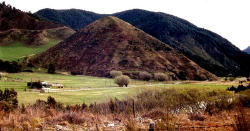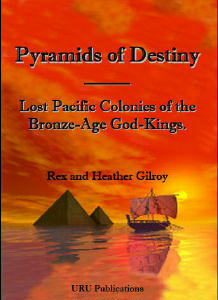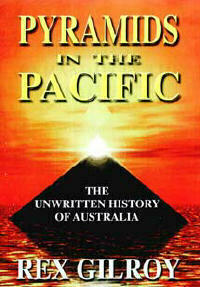
| Pyramids of Destiny – Lost Pacific Colonies of the Bronze-Age God-Kings |
![Mr W.F. [Bill] Gilroy, with the mineralised [limestone] hominid skull](images/skulls/bill-gilroy-holding-skull-sm.jpg) |
The late Mr W.F. [Bill] Gilroy, with the mineralised [limestone] hominid skull found by him on 1st May 1972 at Tarana New South Wales. Now known as Tarana Skull No 1. Photo copyright © Rex Gilroy 2006. In May 1972, while megatools were still being found at the Bathurst site, my father, the late Mr W.F [Bill] Gilroy, was fossicking one day in a creek further east in the Tarana district, when he retrieved a large fossil hominid skull from surface gravels, close to an alluvial bank at a point 6.6m from the water’s edge, and 2m above the water level. The skull was actually an endocast mineralised into limestone, it’s cavity having been filled with mud which had mineralised, whereas the bones had not been preserved. The fossil was distorted, the brain case being flattened at the rear, and part of the lower jaw was fused to the palate. The right side of the skull had been pushed inwards, crushing the right brow ridge. This had been caused by heavy overlying sediments of gravels and large stones pressing upon the skull while it was in a soft, brittle state. |
Pyramids of Destiny – Lost Pacific Colonies of the Bronze-Age God-Kings
by Rex & Heather Gilroy
Copyright
© Rex Gilroy 2009
| The authors refuse to blindly submit to “political correctness”. We present for the reader an unbiased array of evidence, gathered throughout a lifetime’s field research, and ask only that the reader keep an open mind and draw their own opinion on the ‘unwritten’ history of our ancient past.
In the words of Alexander Fleming [1881-1955]: |
“Today honest inquirers after knowledge object to being gulled by mere pretenders, even if these boast the titles of doctor and professor in a university”.
Augustus Le Plongeon MD. |
Part One.
The Rise of Civilisation Out of Australia – The Children of the Uru.
Chapter One.
Lost Stone-Age Hominid Evolution of Australia.
All skull-types, Eolithic [ie ‘Dawn’] tools and megatools described are in the authors possession.Dear reader, we are about to embark upon a long journey, back to a mysterious and long-hidden and forgotten past, a lost history of incredible magnitude and startling revelations. It is a history of people from the ancient Near and Middle-East/Mediterranean civilisations who, at the dawn of metallurgy sought out a great, mysterious southern paradise land, whose existence had been handed down to them by an earlier world-exploring people, the Uru.
The Uru created the first civilisation on earth is the dawn mists of humankinds’ beginnings, upon the Australian continent, from whence they spread it worldwide. Before we embark upon our journey we must first examine the origins of this people, in order to fully understand how the Old and new World civilisations and cultures came to learn of the existence of the ‘Lost Southern paradise” and its fabled riches.
The origins of the Uru lie in the ‘unknown’ Stone-Age history of Australia, and the appearance of the first modern humans in pre-Aboriginal times. This aspect of our ancient past is a mighty saga in itself. From these primitive beginnings the Uru arose to provide the catalyst which would initiate the mighty historical events that will unfold as the reader progresses through this book.
If we are to believe the conservative, ‘traditional’ dogma concerning Australia’s history of Stone-Age human occupation, then we must accept that our Aboriginal people were the “first Australians”, having arrived here from island south-east Asia around 65-70,000 years ago.The authors believe that nothing could be further from the truth. It is the purpose of this chapter to demonstrate that, rather than being the ‘first’ Australians, our Aboriginal people were but the last Stone-Age immigrants to occupy this landmass. For some time it has been “politically correct” to label every primitive stone tool, skull-type or fossil footprint as ‘Aboriginal’. Yet what if they are not?
Many anthropologists accept [even if in secret] that more than one race of Java-type people once occupied Australia. I argue that their arrival was aided in remote times by a vast land-shelf, containing what are now the islands of southeast Asia, until rising sea-levels flooded this ‘bridge’ towards the close of the last Ice-Age, forcing any future immigrants to reach Australia by water craft.
The Pleistocene period, which lasted from about 2 million to 10,000 years ago, supported a vast number of animal and hominid forms now extinct worldwide. Much of the northern hemisphere was glaciated, creating extremely harsh conditions which differed considerably to those experienced in the southern hemisphere, which included the Australian region.
For, unlike the northern hemisphere, Australia did not experience extensive glaciation, this being confined to the Victoria/New South Wales Alps, and also Tasmania, which like New Guinea, was at that time joined to the Australian mainland.
Apart from the southern Alpine region, the rest of the continent remained ice-free, with a warm and temperate climate, the interior being a land of rich vegetation, forests and lakes fed by extensive river systems, all of which supported a vast population of marsupial, bird and reptilian life, which in turn provided an endless supply of food for our Stone-Age human inhabitants.
It was the age of the ‘megafauna’. Giant kangaroo species ranging in heights of from 3 to 4 metres shared the plains with more than one species of giant flightless bird. One of these flightless giants was Dromornis stirtoni, which reached 3m or more in height, weighing more than 500kg.
Roaming among them was the largest ‘mega-marsupial’ of all, Diprotodon optatum, nearly 3m long by 2m tall at the shoulder. Crocodiles, today restricted to the far northern Australian water courses, in those times enjoyed a distribution deep into South Australia; and the “ancient giant butcher” Megalania prisca Owen, a giant 7m long goanna weighing 700kg, preyed upon animal and human life large and small.
Then somewhere around 30,000 years ago, this Australian Ice-Age world began to vanish forever. The ‘megafauna’ and many other smaller creatures began to vanish. Some scientists postulate two basic causes for this devastating event; changes caused to the climate as the Ice-Age began ending, and the hunting activities of our Aborigines.
Yet, as evidence about to be presented for the presence of far earlier human and near-human inhabitants suggests, the extinction would have to have been a gradual process that extended over a much longer period, accelerated only by the drying up of the continent. As the climate turned warmer, the southern ice-sheet retreated and the vast networks of lakes, swamplands and rivers diminished, the forests retreated, turning the interior of the continent into a vast, parched wasteland.
Meanwhile the melting of the worldwide ice-sheets caused the sea-levels to rise, gradually separating Australia from New Guinea and Tasmania from the mainland; while the remaining land-bridges were flooded to form the present islands of south-east Asia and Melanesia. Also flooded at this time, I argue, was an extension of this great land shelf, which linked Melanesia to New Zealand.
As an open-minded field researcher, I have never been able to accept the ‘traditional’ “nobody before the Aborigines” dogma. Spurred on by this belief I began a search during the mid-1960s for evidence to support my theory of a pre-Aboriginal Stone-Age Australian history. Uncovering the evidence was by no means easy, and it took me three years of fruitless searching before my efforts began to turn up the much needed evidence.Locating an ancient dried-up [Ice-Age] course of the Macquarie River near Bathurst, in Central Western New South Wales, I came upon numbers of massive stone tools projecting from hard soil deposits at a location, which I recognised to be an ancient camp site. These tools consisted of hand-axes, clubs, knives, adzes, hammer stones and other implements, ranging in weights of from 5.5 to 16.5 kg. Such huge ‘megatools’ could only have been made and used by hominids of immense stature and strength.
I afterwards learnt of Aboriginal traditions of a race of giant men and women, the ‘Jogungs’ who once roamed the Blue Mountains-Central West, and who, the Aborigines say, stood well over twice the height of modern humans. In the years ahead I would uncover further ‘megatools’ elsewhere in New South Wales and Central Queensland. Among more recent finds has been a massive ‘chopper’ made of basalt. Measuring 36.5cm tall by 37cm wide and 9cm thick, it weights 20kg and was found at Nundle, south-east of Tamworth, in the New England district of northern New South Wales.
The above specimen is now eclipsed by an over 40kg weight basalt club, recovered alongside a basalt knife of over 30kg weight. These monstrous implements, uncovered from old Pleistocene beds at a Sarina [coastal Queensland] site, could only have been made and used by a race of giants of exceptional height and muscular strength.
On the basis of the ‘megatools’ of the ‘Bathurst giants’, I once postulated that populations of the “Giant Java Man”, Meganthropus palaeojavanicus, had entered Australia. The massive fossilised jaws and teeth of this race, dating back at least 500,000 years BP, have been excavated in Java and China, suggesting a race of hominids of up to 4m height and of immense strength, weighing around several hundred kilograms [at least in the males].
Many anthropologists see Meganthropus as a giant ancestor of the smaller “Java Man”, Homo erectus who gradually evolved into modern humans. I now believe the ‘Bathurst giants’ evolved independently in Australia, a probable genetic mutation of Homo erectus; and if so, this process would imply that Homo erectus had been resident here for a considerable period of time; a proposition supported by the combined researches of leading geneticists and anthropologists worldwide, who suggest that a race can take up to 150,000 years to evolve.
Main Book Index | Mysterious Australia Homepage | URU Homepage | Australian Yowie Research Centre

